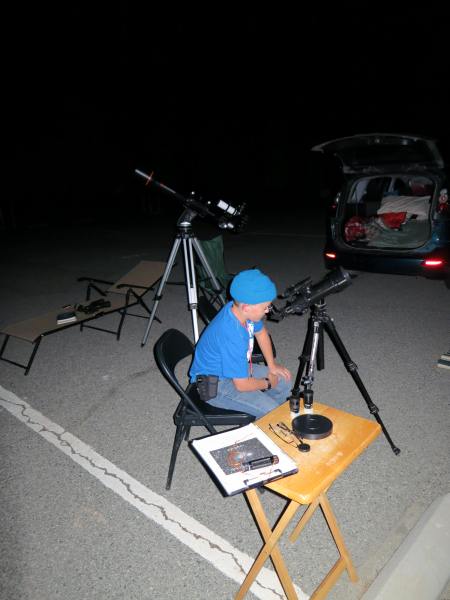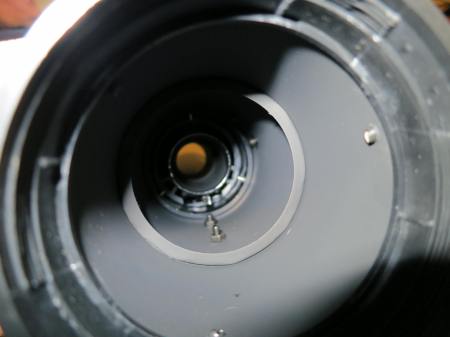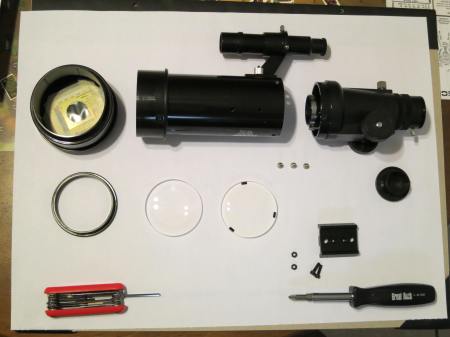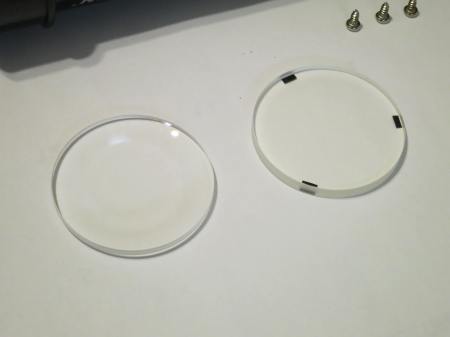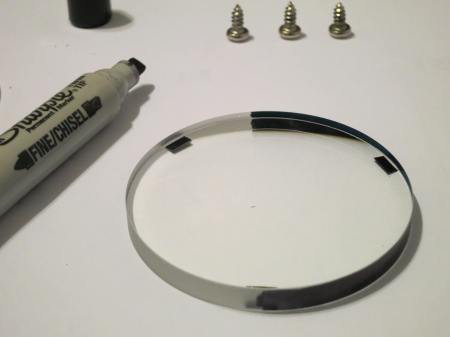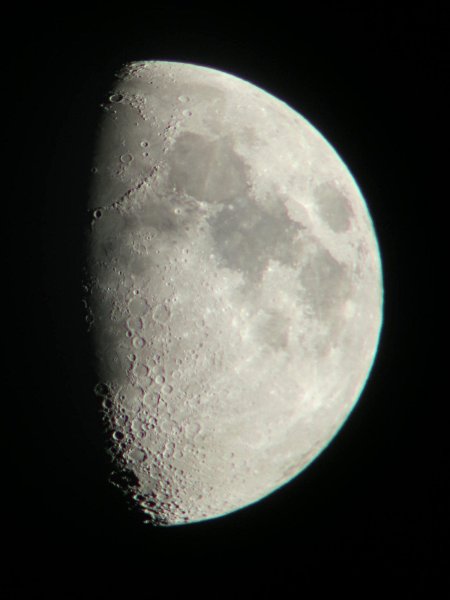Update: This post seems to get a lot of traffic, especially around the holidays. If you’re looking for good gifts for amateur astronomers, including telescopes and binoculars that won’t break the bank, you may also be interested in myastronomical wish list for beginning stargazers.
– – – – – – – – – –
Last year I picked up a Celestron Travel Scope 70, mostly because it was cheap (~$65) and I was curious. Except for a couple of quick peeks with the scope, the only serious workouts it got were the transit of Venus and an all-nighter on Mount Baldy.
My feelings at the time–explained here–were that the scope was great a low-power scanning but useless at anything over 50x. Terry Nakazono suspected it was miscollimated, but I’d never collimated a refractor and I had plenty of other stuff to be getting on with, so I let the TS70 languish.
This fall, London has been showing more interest in astronomy and I let him have the TS70 as a hopefully more user-friendly alternative to the Astroscan, which is a cool scope but can be a real PITA to get on target with.
The first problem is that although the TS70 has an actual dovetail bar, it is so ludicrously short and so far forward on the tube that it is almost impossible to balance the scope. For reasons that escape me at the moment, I have several spare dovetail bars lying around, so I grabbed the next larger one to put on the TS70.
But there’s a problem: the bolts that hold the ludicrously short dovetail (LSD henceforth) on the scope are threaded into nuts inside the tube. You can see those nuts and bolts at the bottom of the tube in the middle distance in the above photo. But you can only see them because I had to remove the objective lens to get this picture.
Well, in for a penny, in for a pound: I disassembled the whole damn scope. Here are the bits. The hex wrench set and screwdriver are mine, the solar film inside the lens cap (described here) is one of my hacks, but the rest is as it came from the factory. Only, you know, taken apart. From 12:00, the bits are:
- the tube with the finder still attached;
- three screws for attaching the focuser to the tube;
- said focuser;
- the black plastic dust cap from the focuser;
- the LSD, its two hex bolts, and their nuts;
- the two pieces of glass that make up the objective lens;
- the retaining ring for the objective lens;
- the dust cap (with solar film) for the objective lens, with the dew shield inside.
The dew shield slides off, and the retaining ring for the objective lens simply unscrews. There’s nothing else holding the two components of the objective lens in; once the retaining ring is off you can simply tilt the tube down and let them fall out–onto something soft (so they don’t get scratched), that isn’t your hand (so they don’t get smudged with oils). The focuser is held into the tube with the three screws, and the LSD is held on with the two bolts and their nuts. So there are really only five fasteners holding the scope together, or six if you count the objective lens retaining ring.
So, about that objective lens. This is an achromatic doublet, meaning that it has two pieces of glass of different compositions (the ‘crown’ and the ‘flint’), to bring more than one color of light to focus at once. In the above photo, the crown is on the left and the flint is on the right. They are different colors, but I’m not sure if that’s because of different light transmission or different coatings. Note the three little foil spacers on the flint, which keep the two lenses at the proper distance.
IF you ever disassemble a multi-element lens, it is extremely important that you keep the parts not only in the right order, but also facing the right way, or you are going to waste a lot of time trying different arrangements (and risking damage to the glass) until you discover how they go together. Better to just keep track of them as they come out.
Next item: unless their edges are blackened, lenses suffer from internal reflections, which cause reduced contrast at the eyepiece. Lots of cheap scopes and eyepieces have un-blackened lens edges, so whenever I take something apart, I blacken the edges. I use a sharpie, two coats, but I’m sure there are other ways.
Aaanyway, the retaining ring for the objective lens is almost always too tight when the scope ships from the factory, and simply unscrewing the ring and gently shaking the tube to settle the lenses is often enough to improve collimation. And that’s all I did here.
So how’d it work out? Last summer, I wrote:
The scope starts to pant around 40x and anything north of 60x is just bad…. Trying to achieve focus on planets is maddening. Jupiter goes from a vertical fan of red light on one side of focus to a horizontal fan of blue light on the other, and only sort of flirts with being a clean disk in between those extremes, at an infinitesimally tiny point that the rack-and-pinion focuser tends to shoot right past.
But Saturday night out at the Salton Sea, the reassembled Travel Scope 70 was like a brand new scope. Images were still pretty crisp at 67x with a 6mm Orion Expanse, and going up to 133x with a Barlow did not just add empty magnification. Here are my observations on different objects.
Polaris
At midnight, I split Polaris with the TS70 using the 6mm Expanse. I note this because In his review of the TeleVue 76 (an $1800 scope), Ed Ting wrote,
There was a time, not terribly long ago, when splitting Polaris was said to be a good test for a three inch scope. In today’s brave new apochromatic world, however, splitting Polaris is something of a joke. Polaris is easy. The double-double is easy.
That’s cool, but the TS70 is not an apochromat (a three-lens-element scope with better control of false color and therefore usually sharper optics than an achromat), nor is it a three-inch scope (2.75″ to be exact). So the fact that Polaris was cleanly split at relatively low magnification (67x) has to be a win.
Epsilon Lyrae
What about the double-double, aka Epsilon Lyrae? I Barlowed the 6mm Expanse to get 133x, which is where I run out of eyepieces and Barlows to increase the magnification on this scope. The northern member, ε1, was clearly elongated but not cleanly split, but ε2 was cleanly split. That’s a little nuts, because ε2 has a narrower separation (2.3 arc seconds) than ε1 (2.6 arc seconds), so it should be harder. I can think of several possible explanations, most having to do with the fact that the ε1 pairs were lined up horizontally in the sky at 12:20 AM, whereas the ε2 pairs were lined up vertically:
- the scope might have some astigmatism that is more pronounced horizontally than vertically;
- my eyes might be more sensitive to vertical than to horizontal separations (I have no idea if this is true, but it’s possible. Maybe I should check some time.);
- the separations were so seeing-dependent (even ε2 was not cleanly split all the time) that any unevenness in the atmospheric turbulence between me and the stars–say, the heat plume from a distant campfire–might have thrown things one way or another;
- the more pronounced brightness difference between the ε1 components (magnitudes 4.7 and 6.2) compared to the ε2 components (5.1 and 5.5), although not normally a factor, might have made that one a tougher split since I was working at the hairy edge of what the scope and the conditions would support.
Anyway, since the closer pair of the double-double was cleanly split even under the less-than-perfect conditions Saturday night, I feel confident saying that this scope will split the double-double.
Jupiter
From my notebook:
1:50 AM. Jupiter in TS70 with 25mm Plossl (16x), just a bright spot. In 12mm Plossl (33x), a disk with two bands. In 6mm Expanse (67x), hints of more than 2 belts during moments of steady seeing, but bad seeing easily visible in image–Jupiter looks like it is on fire. Barlowed 6mm Expanse (133x): this is too much mag. No new detail, and previously seen belts and zones are harder to make out. No problem focusing using moons, though–I think problems are seeing, not scope.
3:57 AM. TS70 to Jupiter, in 6mm Expanse (67x, definitely more than 2 belts/zones showing now that Jupiter is higher in the sky. Planet is still visibly “burning” in the bad seeing. Three to four belts visible, meaning at least two different belts in addition to the bold equatorial belts, but hard to hold both extra belts at one.
Trapezium in Orion
Again from the notebook:
- 25mm Plossl (16x) – 2 components (3 visible, but only 2 cleanly split)
- 17mm Plossl (24x) – 3 components
- 12mm Plossl (33x) – 4 components cleanly split
Misc
Mars was a visible disk in 6mm Expanse, but swimming in the near-horizon murk near Regulus.
M81 and M82 easily visible in 25mm Plossl (16x), showing some detail in 12mm Plossl (33x).
M31, M32, and M110 visible in one field with 12mm Plossl (33x).
I spent some time on the moon, and snapped the photo above using a Canon S100 point-and-shoot and a 25mm Plossl. I flip-flopped it left-to-right and lightly sharpened it in GIMP, but didn’t mess with the brightness or color. It’s not an amazing image–a 90mm Mak will thoroughly spank this scope (proof)–but it’s not bad.
Conclusion
So, I have to revise my opinion of this scope. As supplied, I still have major reservations:
- the tripod is wretched, and struggles to hold a small point-and-shoot digital camera stably, let alone a telescope;
- the finder is a joke: too small to start with, then stopped down, and using plastic lenses to boot. But it makes a decent sight tube if you strip out the guts. London thinks the stripped version is the bee’s knees;
- supplied backpack is okay, but no pockets inside or out, and only one partial divider inside (not that you’re buying this for the backpack, just sayin’);
- eyepieces are nothing special and replacing them should be a top priority;
- as supplied, my scope had two major problems: the LSD, which all TS70s ought to share, and badly miscollimated optics on this sample, which were easy enough to fix by completely disassembling the telescope and voiding the waranty. Also, focus is still a hairy procedure at high powers, and it is easy to overshoot best focus.
However, if you’re willing to buy or build a new mount and put in a little elbow grease, there is a surprisingly capable scope lurking inside this unassuming package–one that is capable of doing useful work on the observing field. Even with mostly plastic, jokey accessories, this scope is still a decent deal, although I shudder to think about the many unfortunate users who try to use the scope on the supplied tripod.
I note that according to the commonly-used “50x per inch of aperture” rule of thumb for max magnification, a 2.75-inch scope ought to be good up to 138x, which is pretty darned close to what I was working at (133x). So to be fair all I have established here is that the scope is adequate, according to one widely-used and fairly conservative guideline. But it’s so much better now than it was last summer–an actual observing tool, not just a toy. And that’s a win.

